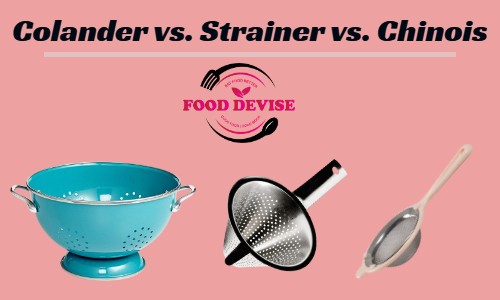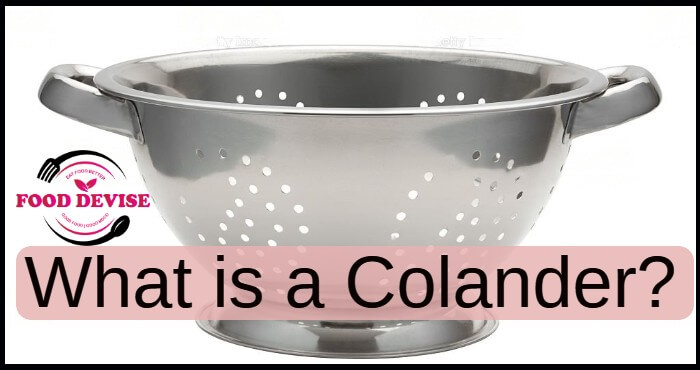Use a colander to strain, drain, and rinse food. Typically made of metal, plastic, or silicone with a large bowl-shaped body and small holes or perforations. Remove excess water, oil, or other liquids from foods such as pasta, rice, vegetables, and fruit.
Wash and rinse produce before cooking or eating. Find a colander in a variety of sizes and shapes to suit different needs and place. Colander in the sink or over a bowl to catch liquids as they drain.
What is a Colander?
Use a colander to rinse vegetables, drain pasta, or sift flour and other dry ingredients. Rinse with water or place in the dishwasher to easily clean them. Colanders are useful tools for preparing and cooking food, and you can find them in a range of sizes and shapes to place over a sink or a bowl to catch the liquid as it drains through the perforations.
Colander vs. Strainer vs. Chinois

A colander is a bowl-shaped kitchen utensil with holes in it, used for draining liquid from boiled or rinsed food. Strain pasta, rice, vegetables, and other types of food with a colander typically made of metal or plastic.
A strainer is a utensil with a handle and a fine mesh or perforated metal or plastic bowl, used for separating solid particles from a liquid. Strain soups, sauces, and other types of liquid foods to remove lumps or other unwanted particles often.
A chinois is a conical strainer with a very fine mesh. It is used to strain sauces and other liquid foods, creating a smooth, velvety consistency. Chinoises typically consist of stainless steel and have a long handle for easy use. Professional kitchens often use Chinoises and consider them a specialty item.
A colander generally drains and rinses food, a strainer separates solid particles from a liquid, and a chinois produces a smooth, velvety consistency in sauces and other liquid foods.
Why You Need a Colander in Your Kitchen
Use a colander to strain or rinse food such as pasta, vegetables, and rice. It is a useful tool to have in your kitchen because it allows you to easily and quickly drain excess water or liquid from food.
After all, here are some specific reasons why you might want to have a colander in your kitchen:
To rinse and drain pasta: When cooking pasta, you can use a colander to drain the hot water from the pasta after it has cooked. This allows you to easily remove the pasta from the pot without spilling any water.
To rinse and drain vegetables: You can use a colander to rinse and drain vegetables, such as broccoli or cauliflower, before cooking them. This helps to remove dirt and debris and ensures that your vegetables are clean and ready to be cooked.
To rinse and drain rice: A colander is also useful for rinsing and draining rice before cooking it. This helps to remove excess starch and ensures that the rice is light and fluffy when cooked.
To strain soups and stews: You can use a colander to strain soups and stews to remove solid ingredients, such as vegetables or meat, from the liquid. This allows you to easily separate the solids from the broth or sauce.
However, Use a colander in your kitchen for various food preparation and cooking tasks; it’s an essential and versatile tool.
The Many Uses of a Colander
Use a colander to strain, rinse, or drain food. Colanders usually have a round or oval shape, with a handle and small holes all over the surface. Metal, plastic, or silicone typically makes them and they come in a range of sizes.
Here are some common uses for a colander:
Strain pasta: Colanders are often used to drain pasta after it has been cooked. Simply place the colander in the sink and pour the cooked pasta into it. The water will drain through the holes, leaving the pasta in the colander.
Rinse vegetables: Colanders are also useful for rinsing vegetables, especially leafy greens. Simply fill the colander with water and swish the vegetables around to remove any dirt or debris.
Drain canned goods: If you need to drain canned goods, such as beans or diced tomatoes, a colander can be used to do so. Simply open the can and pour the contents into the colander to drain off any excess liquid.
Strain broth: If you’re making broth or stock and need to remove any solids, a colander can be used to strain the liquid.
Wash berries: Colanders are great for washing small fruits, such as berries, because the holes allow water to pass through easily.
Serve salad: Colanders can also be used as a serving dish for salad. Simply place the colander on a plate or in a bowl and fill it with salad greens. The excess dressing will drain through the holes, leaving the greens crisp and fresh.
Draining Canned Food
Draining canned food refers to the process of removing excess liquid or juice from the can before consuming the food. Reduce the amount of sodium or other additives and improve the texture and taste of the food by often doing this.
There are a few different methods for draining canned food, depending on the type of food and the desired outcome. One common method is to simply open the can and pour the contents into a colander or strainer placed over a bowl or sink. The liquid will drain out, leaving the solid food behind.
Another method is to use a can opener to carefully cut around the top edge of the can, removing the entire top of the can in one piece. This allows you to easily scoop out the food without any liquid being present.
However, Properly washing and sanitizing any utensils or surfaces that come into contact with canned food is important. Additionally, properly storing the food once it has been opened, regardless of the method used, is also important to prevent spoilage.
Collecting Colanders
Collecting colanders can be a fun and interesting hobby for those who enjoy kitchen gadgets and utensils. Use colanders to drain, rinse, and sift various types of food like pasta, rice, vegetables, and fruits. You can find them in various sizes, materials, and designs at kitchen stores, online retailers, and thrift shops.
There are many different ways to collect colanders. Some collectors focus on a specific type of colander, such as vintage colanders made of metal or enamel, or colanders with unique shapes or designs. Others may collect colanders made of different materials, such as plastic, silicone, or wood.
After that, you can add charm and individuality to your kitchen by collecting colanders. Additionally, you can discover the history and development of this practical kitchen utensil. Interacting with other collectors can be a fun way to learn more about different colander styles and makers.
Conclusion
Use a colander to strain, rinse, or drain food such as pasta, vegetables, and fruits. Typically made of metal, plastic, or silicone, a colander has a bowl-shaped body with perforations or holes on the surface, which allows liquid to pass through while retaining the solid food. Various sizes and shapes of colanders make them a useful tool in any kitchen for serving different dishes.

Hello, my name is Lora J Fusco, and I am a passionate chef with a wealth of experience in the culinary world. I am not in the kitchen making meals. I love to share my insights and adventures by writing on my blog.
Food and cooking are not just my job but also my passion. I am thrilled to have the chance to connect with you through my writing. Welcome to my space, and I hope you enjoy exploring the wonderful world of food with me!

